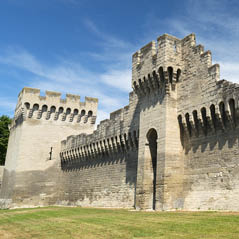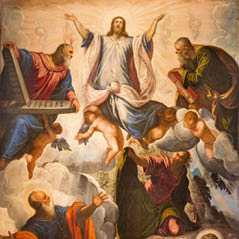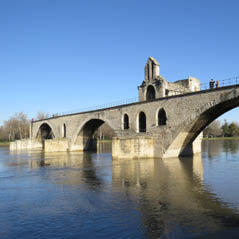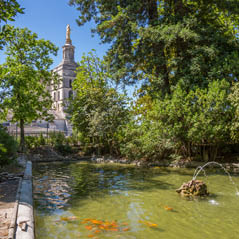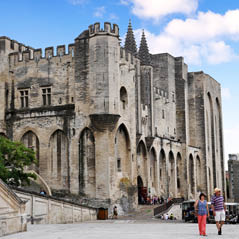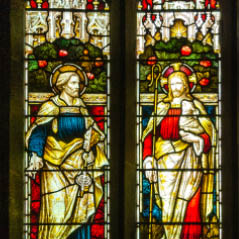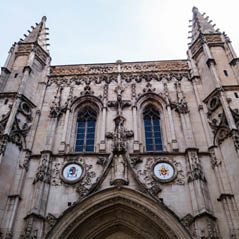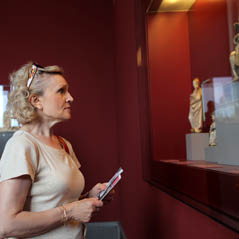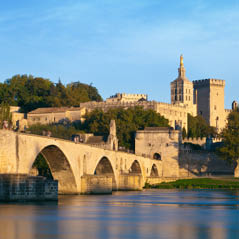Why visit Avignon
History
When visiting Avignon, many of our guests say they feel they’ve travelled back in time. Ancient walls still border this city, with fortified towers and religious buildings virtually untouched since their creation. Walking alongside local residents and experts, you’ll gain a profound, new understanding of France’s storied past.
Avignon City Walls
Discover the legacy behind this aptly named “walled city” as a local expert gives you a walking tour along the historic streets of Avignon. Our travelers learn a lot about the construction and significance of this 14th century architectural feat.
Musée du Petit Palais
For a mix of history and culture, consider the Musée du Petit Palais. This Gothic-designed fort features notable Italian and Provençal paintings from the 13th to the 15th century. We suggest this stop for fans of medieval and Renaissance art – as you’ll find an outstanding collection here.
Saint Bénézet Bridge
Named after Pastor Bénezet, the Saint Bénezet Bridge is an iconic site in Avignon filled with history and legend. After having three saintly visions advise him to build a bridge across the Rhône, Pastor Bénezet urged the townspeople of Avignon to construct the bridge. While met with some resistance, Pastor Bénezet was gifted with a godlike strength and raised a large rock, compelling the people of the city to build the bridge. During your free time in Avignon visit the cobbled bridge to take in great views and an even greater story.
Rocher des Doms
Referred to as the cradle of Avignon, the Rocher des Doms is a natural site covering seven acres of the city’s landscape. Used as a grazing site for livestock in the Middle Ages, these lush grounds are a place of respite and resplendent views – ideal for a break while touring.
Religion
Avignon has been considered holy land for Christians since the Middle Ages. We know that visiting Avignon’s sacred sites is of importance to many of our travellers, so we rely on the expertise of local guides so our travellers walk away moved by Avignon’s divine spirit.
Palais des Papes (Papal Palace)
Listen to the fascinating stories of the papacy as one of Avignon’s locals guides you through the sacred Palais des Papes. The Palais des Papes was one of the most important monuments in Christianity during the 14th century. It is considered a UNESCO World Heritage site and served as the seat of the papacy for seventy years!
Avignon Cathedral
Nearby the Palais des Papes is the Avignon Cathedral. Before you walk inside to see ancient frescoes and Gothic tombs of Avignon’s popes, look skyward. Crowning the top of the church is a large gilded Virgin Mary statue from the 19th century. Our guides say you can see her glowing figure in many different parts of the city.
Church of Saint-Agricola
One of the oldest churches in Avignon is the Church of Saint-Agricola, named for the patron Saint and protector of agriculture. The Church of St. Agricola has appeared in texts from as early as the 11th century. While there, be sure to see the paintings by Nicolas Mignard and Pierre Parrocel and the stone reredos by Boachon, representing the Annunciation.
Church Saint Didier
This gothic-designed church has plenty of ancient history behind its walls. As you tour Avignon, keep an ear out for the ringing of the church’s bell, housed in a massive six-sided bell tower. Inside, you’ll find relics from Saint Benezet and Saint Peter of Luxembourg.
Attractions
In addition to having a strong past rooted in religion, Avignon has established a rich culture filled with a variety of attractions. From the famous Festival of Avignon, gourmet cuisine and museums, we find that our travellers are often pleasantly surprised by this charming city.
Musée Calvet
Considered a “Museum of France” due to its quantity of important collections, the Museum Calvet is one of Avignon’s oldest museums. The museum is housed in an 18th century mansion and contains works from ethnology to ceramics, furniture and fine arts. If you have an unplanned day in Avignon this is a great location to take in some art.
Place de l'Horloge
In the heart of Avignon you’ll find the beautiful city square better known as the Place de l’Horloge. Though the clock after which the square is named is hard to see, you can walk to the iconic city hall and opera easily. During your free time in Provence this is the perfect spot to enjoy a leisurely afternoon or a romantic night out.
Les Halles Market
For a true taste of local Avignon cuisine, visit Les Halles Market. Marked by a large wall of lush greenery, the inside of Les Halles contains a bevy of vendors selling Provençal food, wine, and treats. After seeing the city highlights with your group, indulge in every gastronomical desire.
The Rhone River
The Rhone River is a significant body of water that’s been crucial to Avignon’s success and prosperity as a city. Since medieval times, the Rhone was the connecting point between Avignon and the Mediterranean, allowing for trade and commerce to occur. We suggest a journey along the banks of Avignon on a lunch or dinner cruise for a vantage point you won’t get anywhere else.
